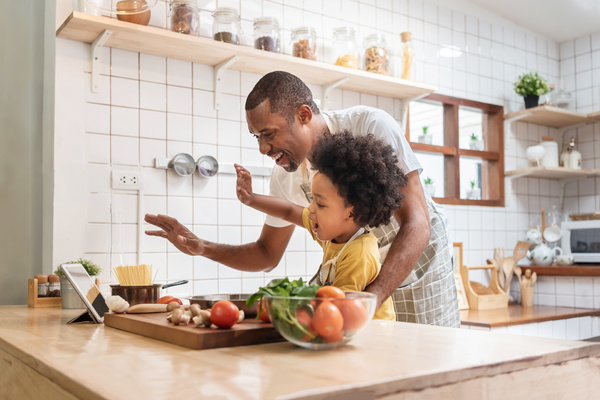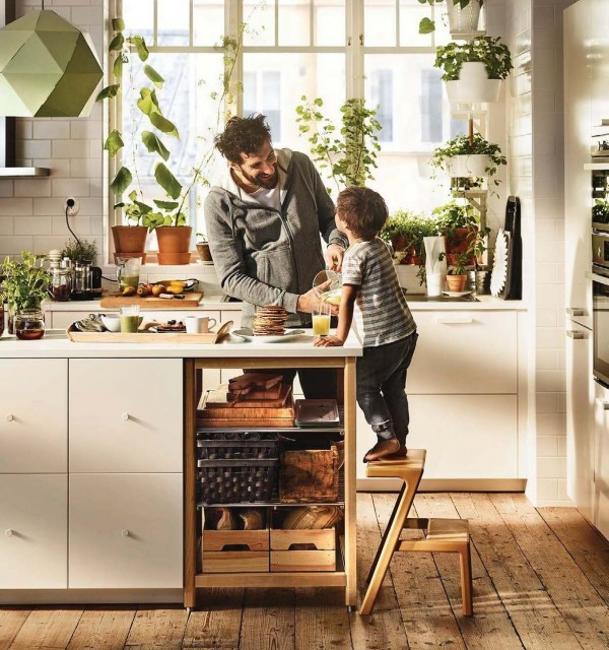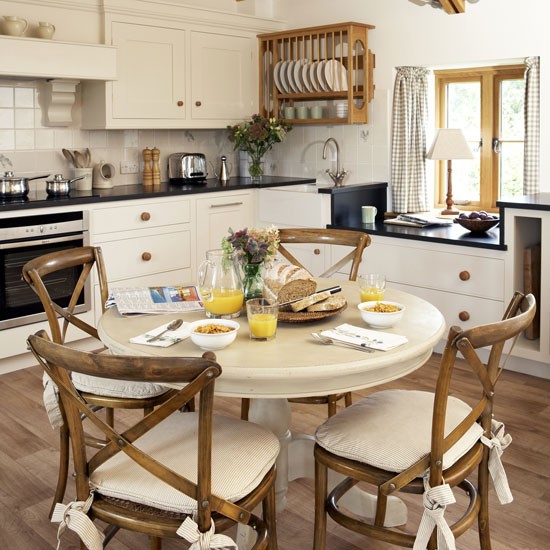If there are children in the house, the demands on a kitchen increase. But what should you consider when planning a well-functioning family kitchen and what little tricks can you use to create enough space for (safe) cooking with children? Your kitchen planner tells you the most important aspects when designing your new family kitchen!

If planned correctly, a family kitchen offers countless possibilities and space for the whole family to develop. Even if you don’t have any children yet, it makes sense to consider the possibility of having children when planning your kitchen, especially for a condominium or your own house. Design your kitchen right from the start so that you have plenty of storage space and storage space. Because if baby bottles, untidy dishes and children’s chaos suddenly appear at home, you will be happy about it.
Table of Contents
Plan your family kitchen generously
Which brings us to the most important point. What a family kitchen needs above all is plenty of space!
There should be enough storage space not only in the kitchen cupboards , but also the space between the furniture, on the worktop and at the dining table should be generous.
The be-all and end-all is a good room layout that allows for generous work surfaces and at the same time allows for the shortest possible walking distances in the so-called operational triangle (preparation, cooking, washing up). In many cases, a kitchen island is particularly suitable for this, where the open cookbook can also find its place. However, it needs a sufficiently large space and is particularly suitable if it is an open kitchen that flows into a more spacious dining area or living room.
L-shaped kitchens and possibly the U-shaped kitchen are particularly suitable for smaller rooms. These kitchen shapes offer plenty of space for cupboards and surrounding worktops.
The space requirement unites all family kitchens. However, when it comes to usage and style, every family’s needs are different. The kitchen should be individually adapted accordingly.
One-man show or cooking with children?
In the different phases of development, children sometimes want to help more and sometimes less with the preparation of food in the kitchen. However, this also means that the kitchen must be designed in such a way that the children can participate in the kitchen work with enough space and freedom of movement. In many cases, a simple stool that brings the little ones up to the height of the worktop can help.
By the way: Regular cooking together can help to teach children how to handle food consciously and to introduce them to a healthy diet as early as possible. It is not at all difficult to teach your children important basic rules with simple dishes and thus introduce them to a balanced, healthy diet, which is now neglected in many families. With a nutritional guide for the whole family , parents learn how to lay important foundations for their children’s diet during pregnancy or when feeding complementary foods. In a well-equipped kitchen, preparing meals together is of course much easier.

Organization vs. chaos
Things can quickly become quite chaotic in a busy family kitchen. The cooking utensils and plates from lunch have not yet been put away, nor have all the purchases from the morning. Now the older one has spread out his homework on the table and the kitchen floor has become an adventure playground for Mr. Lemon Squeezer and Mrs. Tea Strainer…
It’s not always easy to keep order in the family kitchen, so here are a few tricks to at least not make the job harder than necessary:
- Kitchen utensils should have a fixed place in cupboards and drawers so that everyone always knows where to find something.
- Inserts for cupboards and drawers help ensure that all kitchen utensils are within easy reach. Long shuffling and searching in deep cupboards can often be the last straw that breaks your patience.
- Items that are used frequently should be placed so that they can be accessed particularly quickly. If there are no knives or other kitchen utensils that pose a risk to the little ones, you can place them in the base cabinets that the children can reach. This way you can encourage them to help out, while at the same time keeping them busy and learning to take responsibility for housework.
- A large sink should definitely be part of every family kitchen. Not only does it make it easier to wash large pans, trays and pots, but it also offers more space for rinsing and preparing ingredients.
- Use materials that are as easy to clean as possible for all kitchen elements and especially the kitchen worktop . Easy-to-clean and hygienic surfaces save a lot of time in the long term.
- And last but not least: keep calm and refrain from perfection . When living with children, it is simply not possible to always have a perfectly tidy household. They also need to be able to spread. It’s best to arrange a time with them in advance when they can help clean up the shared mess.
Cook safely for the family
The issue of safety plays a major role in family kitchens with small children. But how can you cook with children without having to keep your eyes everywhere so that the little ones don’t hurt themselves?
Safe electrical appliances for the family kitchen
The greatest source of danger is the cooking area, stove and oven . When it comes to an electric stove, the first choice is an induction stove , because it only heats the pots, the cooking area itself remains relatively cold.
Today, ovens and steamers are often installed at waist or eye level. This not only prevents the little ones from opening the oven door, but also protects the backs of adults.
Many manufacturers of electrical appliances now also offer models with hidden or recessed controls. On a dishwasher, for example, on the inner top edge of the door and on a stove with recessed knobs that must first be unlocked. In this way, you minimize the risk of children playing with electrical devices unsupervised or accidentally switching the devices on or off.
Cutting and edging
Knives and all potentially injury-causing equipment should be stored in cupboards and drawers that are out of reach of children or secured with appropriate child safety devices such as a drawer lock.
Sharp corners and edges can also be a source of danger. A rounded wooden worktop offers less risk of injury than a natural stone worktop with sharp corners.
Preempt curious children’s hands
Children’s curiosity should never be underestimated. And once they reach a certain age, they will serve themselves everywhere anyway.
Another practical detail for a little more security in the family kitchen are soft closes for cupboards and drawers . This significantly reduces the risk of a little finger getting caught.
It is also helpful to always keep the worktop as tidy and empty as possible. Adolescents like to pull the nearest object that is within reach, even if they cannot see what it is. If it’s the kettle you just used or a fruit knife that was left lying around, the first accident is inevitable.

The family kitchen as a creative and communication space
Even though it is important to make the kitchen as child-proof as possible, you should not completely ignore the aesthetics and quality of living , especially if it is a kitchen-living room. Make compromises, but make sure you feel comfortable in the kitchen.
Because despite all the safety measures, you shouldn’t forget what the family kitchen is actually for: for all family members to cook together and creatively, for the daily family meal, for playing on the floor and playing board games with the family or with friends at the dining table.
Exchange and communication at eye level are valuable for the development of children and for the relationship with parents. A well-planned family kitchen can help stimulate this. Here are a few ideas:
- The play area helps the children to approach cooking in a relaxed manner. Even in smaller kitchens, at least a small corner should be reserved for the children so that you don’t have to listen to the next room while you do housework.
- Magnetic or blackboard walls are a great medium for displaying children’s latest drawings, organizing appointments and timetables, and writing shopping lists and small messages. You can design an entire wall like this – or as an emergency solution, simply use the refrigerator with magnets.
- A kitchen island is ideal for cooking with children. It offers enough space to work together on cookies or dinner. You keep an eye on the little ones while you cook on one side and a new masterpiece is created on the other.
- A large dining table not only offers space for family meals together, but also for homework, kneading and preparing fruit salad.
- Pictures, plants, decorations and colors in the kitchen have a significant impact on the atmosphere. Be creative here!
Make the best of your functional kitchen
Even in the best family kitchen, it won’t always be possible to balance children and housework smoothly. Then it’s time to keep calm, give everyone a break and make the best of it.
Design a Family Kitchen – FAQs
Q: What are some practical kitchen layout ideas for a family kitchen?
A: A practical kitchen layout for a family kitchen would include an open plan design, ample storage solutions, a well-organized traffic flow, and a designated space for a gathering area such as a kitchen island or banquette.
Q: How can I optimize kitchen storage in a family-friendly kitchen?
A: To optimize kitchen storage in a family-friendly kitchen, consider incorporating pull-out drawers, pantry organization systems, overhead cabinetry, and utilizing vertical space with wall-mounted shelves or racks.
Q: What are some family kitchen ideas to create a cozy and inviting space?
A: Family kitchen ideas to create a cozy and inviting space include adding warm lighting, incorporating comfortable seating like bar stools or a banquette, and personalizing the space with elements that reflect your family’s style and personality.
Q: What are the key elements to consider when designing a family-friendly kitchen?
A: Key elements to consider when designing a family-friendly kitchen are durable and easy-to-clean surfaces, a practical layout that allows for easy movement and interaction, ample storage solutions, and a balance of functionality and aesthetics.
Q: How can I improve the traffic flow in my family kitchen?
A: You can improve the traffic flow in your family kitchen by ensuring that there is enough space between key areas such as the cooking zone, sink, and refrigerator, as well as creating clear pathways for movement throughout the kitchen.
Q: What are some storage solutions for kitchen cabinetry in a family kitchen?
A: Some storage solutions for kitchen cabinetry in a family kitchen include pull-out shelves, drawer dividers, vertical tray storage, and customized inserts for organizing pots, pans, and other kitchen essentials.
Q: How can I create a practical and cozy kitchen space for the whole family to gather?
A: You can create a practical and cozy kitchen space for the whole family to gather by incorporating a multifunctional kitchen island, a comfortable seating area, a designated kids’ zone, and considering the kitchen as the heart of the home.
Q: What are some kitchen design tips for a family-friendly kitchen remodel?
A: Some kitchen design tips for a family-friendly kitchen remodel include prioritizing functionality, incorporating durable materials, maximizing storage, ensuring adequate lighting, and creating designated areas for different family activities.
Q: How can I make my kitchen more family-friendly and welcoming?
A: You can make your kitchen more family-friendly and welcoming by adding elements such as a cozy banquette, creating a designated homework or activity area, incorporating vibrant colors, and integrating personal touches that reflect your family’s lifestyle.
Q: What are some design tricks to ensure a good kitchen and living space flow in a family kitchen?
A: Some design tricks to ensure a good kitchen and living space flow in a family kitchen include using cohesive materials and color palettes, considering sightlines and connectivity between the kitchen and living areas, and integrating versatile furniture and storage solutions.

